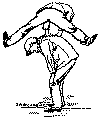By Dan Beard

Fig. 264.
Foot-an'-Half, or Foot and One-Half
The foot mentioned in this title is not the foot marked on a United States standard rule, but a boyish foot enclosed in a rusty shoe and owned by the leader in the game. The boy who is "It" in this game is called First Back. He stands at a taw line and gives a back. The leader is supposed to be the best jumper in the game, and is selected by the First Back for this reason. He tells First Back the height to hold his back and places his hands on First Back's shoulders, gives a leap, spreading his legs, and over he goes. Where the leader's heels strike he makes a mark, and First Back takes his position at this line, astride the line and with his side toward the taw and the other players. All the other boys stand at the taw line and one after another jump over First Back.
When the leader's turn comes around again he makes another jump, not from the taw line but from a point a foot and a half in advance of the first starting point, measured with his own feet. Again he marks where his heels strike, and First Back takes his position at this mark.
This goes on until one of the players fails to clear First Back, usually tumbling him over and rolling both together On the ground. The player who fails is "It," a, First Back, for the next game. Any player may direct First Back to give him a high, low, or medium back before he jumps. Usually each boy calls for as high a back as the leaper thinks he can possibly jump, each player taking pride in making good jumps and being loath to call for a low back unless the distance is great.
Any jumper is allowed to place the middle of his foot on the line, but more than that in advance of taw is called "toeing over the line." If a boy alights with one heel on the taw side of the line which First Back is straddling, it is called " heeling behind the line." Any one of these errors, or jumping out of turn, may "bring a player down. " Generally someone shouts "Something is up," and if he first names the error the boy who is caught becomes First Back. If the right error is unnamed the game proceeds.
Foot-an'-Half, with a Leader and a Foot-an'-Half
Count out to find who shall be "It," or First Back. The First Back then selects the poorest jumper for leader and a good player for Foot-an'-Half, or "header" and "footer." The object of this arrangement is evident when the game proceeds, for it soon becomes plain to the dullest observer that Foot-an'-Half is First Back's friend and is doing his best to set tasks that it will be beyond the powers of the leader to perform.
First Back stands with one foot on each side of the taw line, with his side toward the players, and "gives a back." The leader, followed by all the other players in turn, jumps over First Back. Foot-an'-Half, coming last, jumps as far as he can and marks the spot where his heels strike by a line drawn parallel to the taw line. First Back moves to the line drawn by Foot-an'-Half, and, placing a foot on each side of the line, again gives a back.
The leader may now take a foot and a half measured by his own feet from taw, or take a step beyond the taw line, if he deems the distance too great for a single jump. But should any one of the players following the leader be able to make the jump from taw, the leader becomes First Back and the game commences over.
With good players and a good Foot-an'-Half the distance of First Back from the original taw line sometimes becomes so great that a successful jump is only accomplished by taking a hop, skip, and a jump from the starting point, marking the spot where the heels strike, or three jumps and a hop and making the final jump over First Back from this mark. First Back stands high or low as he may be directed by each player in turn.
Par
is a game of Foot-an'-Half in which the leader marks his jump, which each boy following must equal or exceed. After all have marked their jumps, First Back measures a foot and a half from taw line and takes his position at this point; the leader now jumps from taw over Foot-an'- Half and he must surpass all previous jumps. Failures bring the culprits " down."